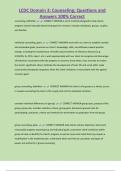LCDC Domain 3: Counseling; Questions and
Answers 100% Correct
counseling, definition CORRECT ANSWER-a set of methods designed to help clients
progress toward mutually determined goals for recovery; includes individuals, groups, couples,
and families
individual counseling, goals CORRECT ANSWER-work with our client to establish realistic
and achievable goals; promote our client's knowledge, skills, and attitudes toward positive
change, including the maintenance of health and prevention of infectious diseases (e.g.
HIV/AIDS, tb, STDs, Hep-C, etc.); work appropriately with our client to recognize and discourage
all behaviors inconsistent with the progress in recovery; know when, how, and why to involve
the client's significant others; facilitate the development of basic life and social skills; make
constructive therapeutic responses when the client's behavior is inconsistent with the agreed
recovery goals
group counseling, definition CORRECT ANSWER-the client is the group as a whole, just as
in couples counseling the client is the couple and not the individual members
consider individual differences in (group) CORRECT ANSWER-group type, purpose of the
group, group size, member selection criteria, group goals, behavioral ground rules for
participating, outcomes, criteria and methods for termination or graduation from the group
group counseling, goals CORRECT ANSWER-help clients achieve objectives; document
measurable progress toward group and individual goals; summarize client's behavior within
group to help us identify the client's progress as well as issues and needs that may require a
modification in the treatment plan; understand when and how to use power, and types of
power and authority in group counseling
, LCDC Domain 3: Counseling; Questions and
Answers 100% Correct
family counseling, definition CORRECT ANSWER-family members contribute in different
ways to the substance use behavior; each member of a family plays a specific role in a family's
problem; understanding family dynamics helps us understand why addiction is called a family
disease; counselor should be aware of laws and resources regarding violence within the family
family survival roles CORRECT ANSWER-hero, scapegoat, lost child, mascot, enabler
family counseling, goals CORRECT ANSWER-help families and significant others
understand the effect of their interactions on substance abuse; assist them in identifying and
stopping harmful patterns of interaction; help them learn healthy strategies and behaviors that
maintain recovery and promote healthy relationships; assist them with referral to appropriate
supportive services
SOAP note taking CORRECT ANSWER-acronym for subjective, objective, assessment, and
plan
subjective, SOAP CORRECT ANSWER-how does the client describe their problem?; this is
usually a quote or statement from the client describing their subjective description of the
problem
objective, SOAP CORRECT ANSWER-what did you observe about this client?; these are
written as factual notations
, LCDC Domain 3: Counseling; Questions and
Answers 100% Correct
assessment, SOAP CORRECT ANSWER-what is your impression about/of this client?
qualities of effective helpers CORRECT ANSWER-have a healthy self-concept, hold
positive beliefs about people, are aware and respectful of cultural differences, have the ability
to listen and understand, and possess empathy, congruence, warmth, compassion, genuineness,
and positive regard
plan, SOAP CORRECT ANSWER-what is your plan with this client?
active listening CORRECT ANSWER-attending skills and reflective listening; through
utilizing active listening skills, the counselor will be able to connect with the client and be able
to reflect the client's emotions, thoughts, and attitudes; attending to verbal/nonverbal aspects
of communication without judging or evaluating; this encourages trust and client self-disclosure
empathy CORRECT ANSWER-the ability to perceive another person's experience and
communicate that perception back to the person
concreteness CORRECT ANSWER-the process by which the counselor relates the vague
aspects of the client in direct expression of feelings and experiences in specific, concrete terms
to assist the client to develop more functional coping skills




